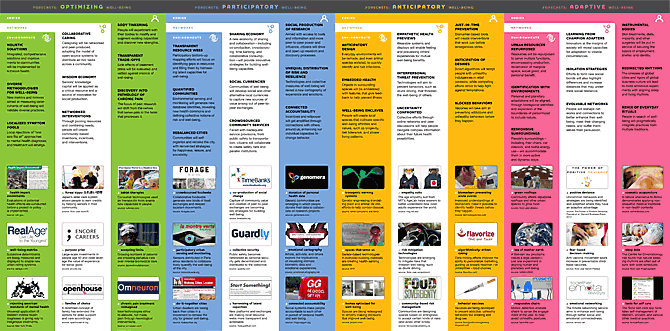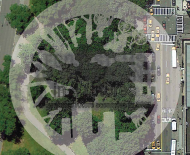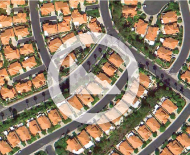Ecosystems of Well-being Map

Ecosystems of Well-being Map
For too long, we've looked at health and well-being only as it relates directly to individual bodies. We measure blood pressure, blood sugar and cholesterol levels and then we prescribe medicines to them within a recommended range. But is that all we should be looking at? Education level, access to clean water and food, and the ability to cope with difficulty have real impacts on people's health and well-being. Something as simple as the level of social trust in a region, for example, has been shown to improve happiness, increase food security, and reduce illness and disease. Our health and well-being is an ecosystem, of which our bodies are but one component part.
Health Horizons' 2011 Map of the Decade—Ecosystems of Well-being (PDF)—focuses on seeing health and well-being through the lens of ecosystems. This new map describes the innovation landscape of a wide range of products and services not traditionally associated with health or health care. It delves into how physical spaces can affect behaviors and genes, while new insights into social systems reveal the profound health influences people have on each other.
Four Forces
In the future, well-being must be understood as part of a process shaped by interdependent and dynamic forces. This map explores four such forces:
- Participatory: Proliferating social structures, despite constraints in the operating environment. The systems that have provided the basic elements of well-being may prove inadequate in the coming decade, but we will also discover that well-being flows from interdependence. With new systems emerging out of peer-to-peer interactions, people will co-create new capacities for well-being.
- Optimizing: Focusing on maximizing quality, not just length, of life. Rather than emphasize extending life spans at any cost, in the next decade the focus will be less on sheer longevity and more on increasing how long people experience good physical, emotional, social, and spiritual health. Resources will be better applied to help enable high-quality, meaningful living.
- Adaptive: Changing with changing circumstances, with allowance for diversities, redundancies, cross-pollination, and mutation. Extreme environments and economic and social disruptions in cities will instigate development of adaptive ecosystems of well-being that enable more inventive, intuitive, and integrative approaches to health and well-being.
- Anticipatory: Using feedback loops to digest and respond to information and anticipate future conditions. Abilities to sense future well-being states will improve dramatically, while at the same time revealing the limits of knowledge about physical health. A more generalized sense of well-being will emerge, to help protect against a variety of possible risks.
Scales of Well-being
New understandings of the role of social and dynamic influences on health are highlighting the importance of imagining responses that operate at multiple scales of intervention. This map
explores how the four dynamic forces shaping the future of well-being ecosystems operate across each of the following scales:
- Bodies: As new understandings of well-being emerge, people will experiment with a wider variety of personal choices—for example, in sleep and time management—to manage their health. These self-experiments will expand the boundaries of health and well-being interventions in the coming decade.
- Networks: Research on the effects of social networks is revealing the complex and profound ways that social groups can affect health and well-being. Over the next decade, a reorganized social structure, from ad hoc groupings to semi-permanent collectives, will aim at using networks to influence well-being ecosystems.
- Environments: Physical spaces and geographic regions are increasingly being linked to capacities for well-being, as well as to health challenges. As large-scale environmental challenges (such as resource scarcities) evolve over the next decade, new ways to work within those constraints to improve well-being will emerge.
This expanded landscape points to a future in which discrete responses to health challenges give way to broader, more collaborative efforts aimed at improving multiple aspects of well-being. Understanding these dynamic, complex, and connected systems will be critical to developing responses that build capacities for well-being.
Publication Date
2011
Download
To download a PDF of this research map:
Purchase
To purchase printed folded copies of the map [$35. each]:







